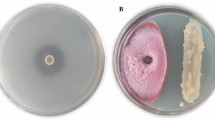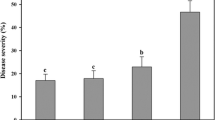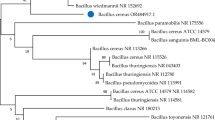Abstract
Bacillus cereus strain Jdm1 was isolated and tested for activity as a biocontrol agent to suppress Meloidogyne incognita. Petri dish test results indicated that Jdm1 culture supernatant significantly inhibited the second-stage juvenile (J2) activity and egg hatching, and also decreased the number of galls on tomato roots in the pot test. Control efficiency reached 43%, with improved growth compared to control plants. In field tests, control efficacies were greater than 50% 30 day post-inoculation, before decreasing. Furthermore, when avermectins were included to manage M. incognita, the yield of tomatoes was increased significantly. The effect of Jdm1 on the bacterial community in the tomato rhizosphere soil was monitored using PCR-denaturing gradient gel electrophoresis (PCR-DGGE) on field plants. DGGE band patterns and principal component analysis showed that application of Jdm1 did not permanently imperil the bacterial community, which recovered soon after inoculation, despite being impacted initially. The plant growth stage had a much greater influence on the bacterial community in tomato rhizosphere soil.





Similar content being viewed by others
References
Atamian HS, Roberts PA, Kaloshian I (2012) High and low throughput screens with root-knot nematodes Meloidogyne spp. J Visu Exp 61:e3629
Bridge J, Page SLJ (1980) Estimation of root-knot nematode infestation levels on roots using a rating chart. Trop Pest Manag 26:296–298
Buckley DH, Schmidt TM (2002) Exploring the biodiversity of soil—a microbial rain forest. In: Staley JT, Reysenbach AL (eds) Biodiversity of microbial life. Wiley-Liss, Inc, New York
Chitwood DJ (2003) Research on plant-parasitic nematode biology conducted by the United States Department of Agriculture, Agricultural Research Service. Pest Manag Sci 59:748–753
Gao GP, Yin DH, Chen SJ, Xia F, Yang J, Li Q, Wang W (2012) Effect of biocontrol agent Pseudomonas fluorescens 2P24 on soil fungal community in cucumber rhizosphere using T-RFLP and DGGE. PLoS One 7:e31806
Glick BR, Patten CL, Penrose DM (1999) Biochemical and genetic mechanisms used by plant growth promoting bacteria. Imperial College Press, London
Gokte N, Swarup G (1988) On the potential of some bacterial biocides against root-knot and cyst nematodes. Indian J Nematol 18:152–153
Heuer H, Krsek M, Baker P, Smalla K, Wellington EMH (1997) Analysis of actinomycete communities by specific amplification of genes encoding 16S rRNA and gel-electrophoretic separation in denaturing gradients. Appl Environ Microbiol 63:3233–3241
Huang XW, Liu JW, Ding JM, He QS, Xiong R, Zhang KQ (2009) The investigation of nematocidal activity in Stenotrophomonas maltophilia G2 and characterization of a novel virulence serine protease. Can J Microbiol 55:934–942
Jetiyanon K, Wittaya-Areekul S, Plianbangchang P (2008) Film coating of seeds with Bacillus cereus RS87 spores for early plant growth enhancement. Can J Microbiol 54:861–867
Li BX, Ren YP, Zhang DX, Xu SY, Mu W, Liu F (2018) Modifying the formulation of abamectin to promote its efficacy on southern root-knot nematode (Meloidogyne incognita) under blending-of-soil and root-irrigation conditions. J Agric Food Chem 66:799–805
Marschner P, Yang CH, Lieberei R, Crowley DE (2001) Soil and plant specific effects on bacterial community composition in the rhizosphere. Soil Biol Biochem 33:1437–1445
Nakatsu CH (2007) Soil microbial community analysis using denaturing gradient gel electrophoresis. Soil Sci Soc Am J 71:562–571
Niu DD, Wang CJ, Guo YH, Jiang CH, Zhang WZ, Wang YP, Guo JH (2012) The plant growth-promoting rhizobacterium Bacillus cereus AR156 induces resistance in tomato with induction and priming of defence response. Biocontrol Sci Technol 22:991–1004
Noling JW, Becker JO (1994) The challenge of research and extension to define and implement alternatives to methyl bromide. J Nematol 26:573–586
Oka Y, Chet I, Spiegel Y (1993) Control of the rootknot nematode Meloidogyne javanica by Bacillus cereus. Biocontrol Sci Technol 3:115–126
Oka Y, Koltai H, Bar-Eyal M, Mor M, Sharon E, Chet I, Spiegel Y (2000) New strategies for the control of plant-parasitic nematodes. Pest Manag Sci 56:983–988
Palomares-Rius JE, Escobar C, Cabrera J, Vovlas A, Castillo P (2017) Anatomical alterations in plant tissues induced by plant-parasitic nematodes. Front Plant Sci 8:1987
Prévost K, Couture G, Shipley B, Brzezinski R, Beaulieu C (2006) Effect of chitosan and a biocontrol streptomycete on field and potato tuber bacterial communities. BioControl 51:533–546
Ramos B, García JAL, Probanza A, Barrientos ML, Gutierrez Mañero FJ (2003) Alterations in the rhizobacterial community associated with European alder growth when inoculated with PGPR strain Bacillus licheniformis. Environ Exp Bot 49:61–68
Reddy PP (2013) Recent advances in crop protection: avermectins. Springer, New Delhi
Sanguinetti CJ, Dias Neto E, Simpson AJ (1994) Rapid silver staining and recovery of PCR products separated on polyacrylamide gels. Biotechniques 17:914–921
Siahpous S, Sahebani N, Aminian H (2011) Change of some defense compounds of cucumber treated with Bacillus cereus and salicylic acid against Meloidogyne javanica. Afr J Plant Sci 5:829–834
Tian BY, Li N, Lian LH, Liu JW, Yang JK, Zhang KQ (2006) Cloning, expression and deletion of the cuticle-degrading protease BLG4 from nematophagous bacterium Brevibacillus laterosporus G4. Arch Microbiol 186:297–305
Topp E, Millar S, Bork H, Welsh M (1998) Effects of marigold (Tagetes sp.) roots on soil microorganisms. Biol Fertil Soils 27:149–154
Vahjen W, Munch JC, Tebbe CC (1995) Carbon source utilization of soil extracted microorganisms as a tool to detect the effects of soil supplemented with genetically engineered and non-engineered Corynebacterium glutamicum and a recombinant peptide at the community level. FEMS Microbiol Ecol 18:317–328
van Overbeek L, van Elsas JD (2008) Effects of plant genotype and growth stage on the structure of bacterial communities associated with potato (Solanum tuberosum L.). FEMS Microbiol Ecol 64:283–296
Wei LH, Xu QY, Wei BQ, Wang YM, Li SM, Chen LF, Guo JH (2010) Screening of antagonistic bacterial strains against Meloidogyne incognita using protease activity. Biocontrol Sci Technol 20:739–750
Xiao TJ, Tan SY, Shen QR, Ran W (2012) Bacillus cereus X5 suppresses root-knot nematode of tomato by colonizing in roots and soil. Afr J Microbiol Res 6:2321–2327
Xu JH, Liu PL, Meng QP, Long H (2004) Characterisation of Meloidogyne species from China using isozyme phenotypes and amplified mitochondrial DNA restriction fragment length polymorphism. Eur J Plant Pathol 110:309–315
Xu YX, Wang GG, Jin J, Liu JJ, Zhang QY, Liu XB (2009) Bacterial communities in soybean rhizosphere in response to soil type, soybean genotype, and their growth stage. Soil Biol Biochem 41:919–925
Acknowledgements
This research was supported by the Fundamental Research Funds for the Central Universities (2017CXNL04) and a Project Funded by the Priority Academic Program Development of Jiangsu Higher Education Institutions.
Author information
Authors and Affiliations
Corresponding author
Ethics declarations
Conflict of interest
The authors have declared that no competing interests exist.
Rights and permissions
About this article
Cite this article
Xiao, L., Wan, JW., Yao, JH. et al. Effects of Bacillus cereus strain Jdm1 on Meloidogyne incognita and the bacterial community in tomato rhizosphere soil. 3 Biotech 8, 319 (2018). https://doi.org/10.1007/s13205-018-1348-2
Received:
Accepted:
Published:
DOI: https://doi.org/10.1007/s13205-018-1348-2




